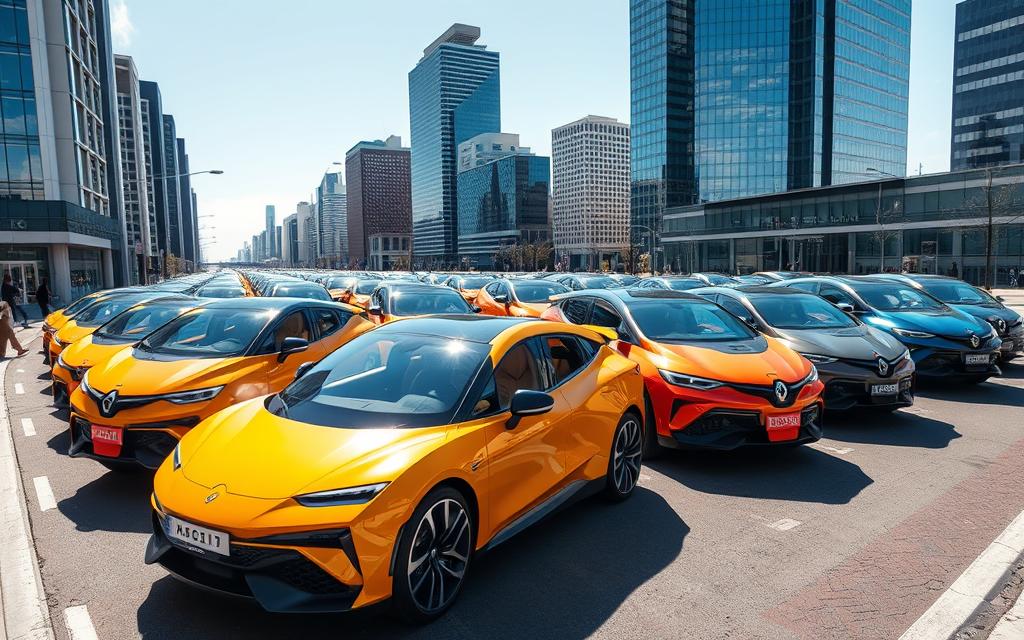Electric vehicle sales in the U.S. hit 1.6 million in 2024. That’s over 10% of all new cars sold. This growth shows more people are choosing electric cars, helped by better technology and efforts to be eco-friendly. Now, America is catching up with the world, where over 17 million electric cars were sold. Companies are also putting more into electric vehicle development to satisfy customers.
The car industry is seeing big changes, with both challenges and chances for growth. Electric cars are leading this change with their cool designs and improved performance. They’re changing how we view travel and what the future of driving looks like.
Understanding EV Technology
Electric vehicle (EV) technology marks a big change in how cars work. Instead of gasoline, these cars use electricity. This shift relies on new tech, including batteries, electric motors, and special brakes that save energy. These parts make cars more efficient and less polluting than old-fashioned cars.
What is Electric Vehicle Technology?
EV technology uses electricity to power clean, green cars. It cuts down on oil use and helps the planet. These cars have advanced batteries that store and use energy well, driving us toward a greener future.
Key Components of Electric Vehicles
The main parts of electric vehicles are very important for them to work right. These parts include:
- Lithium-ion batteries: These batteries store the power that runs the car’s motor. They last a long time and work well.
- Electric motors: They turn electric energy into motion, making the car move.
- Control systems: These smart systems use energy wisely and make sure the car runs smoothly.
Benefits of Electric Vehicles for the Environment
EVs are great for the environment. They cut down a lot on the bad stuff that harms our air. They might even reduce oil use by 1 million barrels each day, making our carbon footprint smaller. Also, when they run on clean energy, they help us fight climate change.
The Transition to Electric Vehicles
The journey towards electric vehicles is fascinating. It shows how people’s choices and government policies have evolved. Once, historic electric cars led the way. Now, societal changes and government actions push the adoption of today’s electric vehicles (EVs).
Historical Overview of Electric Cars
Electric vehicles date back to the late 1800s, when they first became popular. But, the 20th century favored gas-powered cars due to better engine technology. Recently, the interest in EVs spiked again thanks to better batteries and environmental concerns. Now, electric vehicle sales are booming globally, with China in the lead.
The Role of Government Policies
Government policies are key in the shift to electric cars. Countries like the U.S. have rolled out incentives, such as tax credits. These incentives make electric cars more appealing than traditional ones. Programs like the Clean Vehicle Tax Credit show a strong push towards more EVs and cleaner transport.
Consumer Adoption Trends
More and more people are choosing electric cars. This is because of growing eco-awareness and more car choices. Though electric car sales are high, the increase in buyers is expected to even out. Improvements in features, cost, and charging facilities aim to attract even more customers, challenging Tesla’s lead.
Popular Electric Vehicle Models
Several names are leading the way as the electric vehicle market grows. Among these, Tesla is at the forefront, showing what electric cars can do. The Nissan Leaf EV and Ford Mustang Mach-E are also making big impressions. They’re changing how people see electric cars.
Tesla: Innovator in the Industry
Tesla is well-known for its groundbreaking work in electric vehicles. Its Model Y and Model 3 are especially popular, making up a big part of U.S. electric car sales. Tesla keeps aiming high with better range, performance, and tech features.
Nissan Leaf: A Practical Choice
The Nissan Leaf is known for being both affordable and efficient. It was one of the first electric cars aimed at the average driver. It’s perfect for daily use and attracts those who want to be kinder to the environment without spending a lot.
Ford Mustang Mach-E: The New Classic
The Ford Mustang Mach-E marks a new era for Ford. It mixes iconic design with modern electric capabilities. It performs incredibly well and shows Ford’s dedication to electric car innovation. It stands tall among other famous electric vehicles.
| Model | Range (miles) | Starting Price | Key Feature |
|---|---|---|---|
| Tesla Model 3 | 267 | $39,990 | Autopilot |
| Nissan Leaf EV | 226 | $27,400 | Efficient charging |
| Ford Mustang Mach-E | 305 | $43,895 | Performance AWD |
Charging Infrastructure Across the U.S.
The way electric vehicles (EVs) grow in the U.S. is closely linked to more charging places. As people choose cleaner transport, knowing about charging station types, public networks, and home charging is key.
Types of Charging Stations
Charging stations come in three main kinds for EV drivers:
| Charging Station Type | Charging Speed | Typical Use |
|---|---|---|
| Level 1 | 120V, 3-5 miles/hour | Home charging solutions |
| Level 2 | 240V, 10-20 miles/hour | Public charging networks |
| DC Fast Charger | 400V or higher, 60-100 miles/30 minutes | Long-distance travel |
Growth of Public Charging Networks
Public charging networks are changing fast. Both private firms and government help grow EV infrastructure. With more charging spots, drivers rely more on EVs. They can go further, worrying less about charging.
Home Charging Solutions
More EV owners now choose to charge at home. Adding Level 2 chargers at home offers benefits like ease and lower costs. This helps people switch to electric cars easily, using public chargers less.
Environmental Impact of Electric Vehicles
Electric vehicles (EVs) are a big step towards a cleaner, sustainable future. They can greatly lower greenhouse gas emissions if powered by renewable energy. Looking into their environmental impact shows how EVs help achieve green goals.
Reduction in Greenhouse Gas Emissions
Switching to electric vehicles cuts down emissions significantly. Unlike gas cars, which emit lots of carbon dioxide, EVs produce none when charged with green energy. This switch helps make the air cleaner and reduces the nation’s carbon footprint.
Sustainable Battery Production
Sustainable battery production is crucial for the eco-friendliness of EVs. The mining of materials like lithium and cobalt can harm the environment if not done carefully. Companies are finding new ways to make battery production more eco-friendly. This ensures technology advances without hurting the planet.
Recycling and End-of-Life Solutions
It’s important to manage the environmental impact of EV batteries well. This includes good EV battery recycling practices and finding ways to deal with batteries at their life’s end. As more people use EVs, there’s a push to recycle batteries efficiently. This reduces waste and saves valuable materials, making the car industry more sustainable.

| Factor | Impact on Environment | Future Considerations |
|---|---|---|
| Greenhouse Gas Emissions | Significant reduction with renewable charging | Increased adoption of clean energy sources |
| Battery Production | Potential environmental risks from raw material sourcing | Investments in sustainable practices |
| Recycling Solutions | Reduces waste and recycles valuable resources | Development of efficient recycling technologies |
The Cost of Owning an Electric Vehicle
When you think about buying an electric vehicle (EV), the price is a big factor. Understanding the costs helps you know if it’s a good choice. Things like the upfront price, how much you save later, and special deals are important.
Initial Purchase Price vs. Long-Term Savings
Electric vehicles usually cost more at first than regular cars. This might make some people think twice. However, electric cars save you money on gas and upkeep later on. These savings can add up, making EVs a smart choice financially in the long run.
Incentives and Rebates in Different States
To get more people to buy EVs, many places offer special deals. The offers change depending on where you live. Looking into these deals is a smart move to save money. This way, EVs become more affordable for more people.
Maintenance Costs Compared to Gas Vehicles
The cost to keep an EV running is usually less than for gas cars. Since electric motors are simpler, they don’t break down as much. This means you spend less on repairs over time, which is another plus of owning an EV.
The Future of Electric Vehicle Technology
Electric vehicle (EV) technology is quickly moving forward. We see this in improved batteries and the start of self-driving electric cars. Also, new charging methods are making EVs more popular and easy to use.
Advancements in Battery Technology
Better batteries are key for EV progress. Companies are making batteries last longer and charge quicker. They’re also working on batteries that let cars go further before needing a charge. This means future EVs will not just run longer but better meet our daily needs.
Autonomous Electric Vehicles
Self-driving electric cars are exciting. They could make roads safer, cut down traffic, and offer smarter ways to travel. With advances in AI and machine learning, these cars might soon change how we move around cities and help the planet.
Innovations in Charging Technology
New ways to charge EVs are important. Now, we have wireless charging and very fast chargers. These make charging quicker and easier. With better charging options, more people might choose electric cars, making our move to electric smoother.
Challenges Facing Electric Vehicle Adoption
The growth of electric vehicles (EVs) in the U.S. has challenges. These challenges scare away potential buyers. By understanding and addressing these issues, we can guide consumers and find strategic solutions.
Range Anxiety: Is It Real?
Many people are worried about how far EVs can go on a single charge. Advances in battery tech have helped. But, the fear of not reaching their destination before running out of charge is still there. This fear makes buyers think twice and affects their confidence in EVs.
Cost Barriers to Entry
Electric vehicles often cost more upfront. This high cost is especially hard for those with less money. Though deals and tax breaks help, we must make EVs more affordable to everyone.
Infrastructure Limitations
Lack of charging stations is another big issue. Many places don’t have enough spots to charge EVs. This makes it tough for people to consider buying an EV. We need to invest more in charging networks. This will help make the switch to EVs smoother and more attractive.
Community and Economic Impact
The electric vehicle (EV) market is changing communities and the economy in the U.S. As more people want EVs, we see more jobs in this area. This helps the economy grow and encourages local EV projects. This change needs support from local governments and businesses, showing a big shift in car making for the future.
Job Creation in the EV Sector
As car makers and service companies grow, job creation in the EV sector becomes key. Jobs vary from making and putting together cars to creating batteries and setting up chargers. This growth boosts local economies and gives people new career choices.
Local Governments Supporting EV Initiatives
Local governments are helping with the switch to electric cars through different programs. They fund charging station setups, run ads to explain EV benefits, and offer perks for eco-friendly choices. This support gets more people involved and supports the spread of EVs.
The Future of Auto Manufacturing
The future of car making is leaning heavily towards electric vehicles. Old-school car makers are adding more EVs to their lineup, and new players are bringing fresh ideas. This move towards greener cars matches what buyers want and what the planet needs.
Electric Vehicles and Technology Integration
As we head towards greener ways to move around, electric vehicles (EVs) are getting smarter to attract those who love technology. They now come with top-notch entertainment systems, easy smart charging, and better safety tools. These high-tech features make driving fun and managing power easier.
Smart Features in EVs
One key feature is real-time data monitoring. It lets drivers see how their vehicle is doing and how much energy they’re using right on their screens. This cool tech helps users make better choices about when to drive and charge, leading to more effective use of power.
Vehicle-to-Grid Technology
Then there’s the vehicle-to-grid technology. It’s a game-changer. It lets EVs not just take power from the grid but also give back extra power. This two-way power flow is great for home power needs and even helps keep the entire power system stable. It shows how EVs could play a big part in our future energy setups.
Connectivity and User Experience
Today’s electric vehicles offer great connectivity that makes driving better. Drivers get to know their way, battery status, and how well their vehicle is performing easily. This high level of connection proves that EVs are more than just cars. They’re smart devices that make driving a richer experience.




